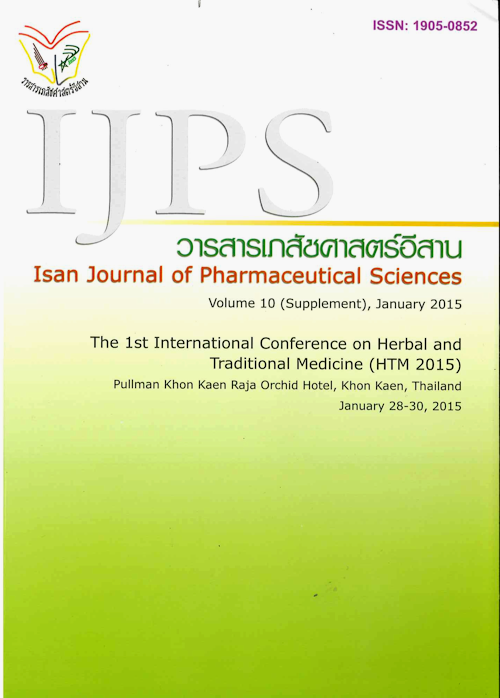Risk Assessment of Municipal Tap Water Supply for Trihalomethanes, the Chlorination Byproducts: Comparison of Different Boiling Methods
Main Article Content
Abstract
trihalomethanes (THMs) in drinking water. Municipal tap water samples were collected in Ban Samran
district, Khon Kaen Province, 2 times in November 2014. Methods: The water samples were analyzed
for baseline THMs and then heated in an open and a closed boiler simultaneously until boiled for 5
min, and re-heated again at 10 and 24 hours. At each boiling interval, water samples were analyzed
for THMs by Purge and Trap method with a gas chromatography- electron capture detector. The
water samples were also tested for cytotoxicity using MTT assay with Chang liver cells. Health risk of
THMs via ingestion model was also estimated. Results: The occurrence of THMs levels prior to
boiling was chloroform (CF)> bromodichlomethane (BDCM)> chlorodibromomethane (CDBM)> bromoform
(BF). The rank of lifetime additional cancer risk was BDCM>CF>CDBM>BF. With
increasing boiling time the concentration of THMs were reduced effectively. The test of cell toxicity via
MTT assay revealed that boiling of the water samples did not affect the Chang liver cell viability.
Conclusion: Since the total lifetime additional cancer risk from all THMs in water was marginally
acceptable and BDCM presented the highest cancer risk of all THMs studied, compounds providing
bromide ions should be avoided in use to reduce the cancer risk for water environment.
Article Details
In the case that some parts are used by others The author must Confirm that obtaining permission to use some of the original authors. And must attach evidence That the permission has been included
References
Carpi, M., Zufall, C. (2003). GC analysis of trihalomethanes in drinking water - A rapid and direct quantitative method. Lc Gc N. Am., 88-91.
Do M, Ratanapan C, Suksaroj T. (2011). Health risk from exposure to trihalomethane in swimming pools. Journal of pubic health and development. Dev. 9(2):208-22.
LaGrega, M.D., Buckingham, P.L., Evans, J.C., (2001). Hazardous waste Management. McGraw-Hill. 2ndEdition. Washing ton, D.C., cited by Mallika Panyakapo and Pongsi Paopuree. (2007). Occurrence of Trihalomethanes in chlorinated drinking water: a case study of the water supply system of Nakhon Pathom municipality. Department of environmental science, Faculty of Science, Silapakorn University.
Intranont, K. (2005). Ergonomics book. Chulalongkorn University Press. Chulalongkorn University, Bangkok, cited by Mallika Panyakapo and Pongsi Paopuree. (2007). Occurrence of Trihalomethanes in chlorinated drinking water: a case study of the water supply system of Nakhon Pathom municipality. Department of environmental science, Faculty of Science, Silapakorn University.
Mosmann, T. (1983). Rapid colorimetric for cellular growth and survival: Application to roliferation and cytotoxicity assay. J Immuno Methods 65: 55-63.
IARC. (1999). Monographs on the Evaluation of Carcinogenic Risks to Humans. Some Chemicals that Cause Tumours of the Kidney or Urinary Bladder in Rodents and Some Other Substances, Vol.73, International Agency for Research on Cancer, Lyon, France.
Rockett L., Ewence A., Gardner M., Young W. and Rumsby P. A., (2010). Drinking water inspectorate. A review of thecurrent knowledge on dermal and inhalation toxicity of regulated THMs. WRC Swindon, Frankland Road, Blagrove, Swidon, Wiltshire.
US-EPA. (1989). Risk assessment guidance for superfund, Vol 1, Human health evaluation manual EPA/540/1-89/002, Washington DC.
US-EPA. (1997). Exposure factors handbook. General Factors I, US EPA, Washington.
US-EPA. (1998). Disinfectants and disinfection by – products. Rule: Final Rule, “Fed Reg. 63.241, Dec16.
World Health Organization. (1998). Trihalomethanesin drinking water guidelines for drinking water quality, 2nd ed. Addendum to Vol. 2. Health criteria and other supporting information. Geneva.


